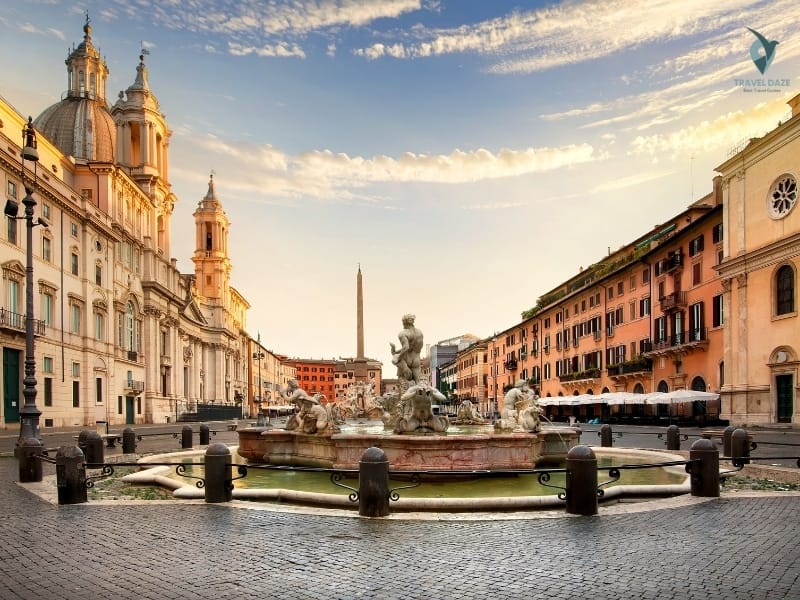Have you ever thought about what is beyond the Colosseum and the Vatican? I did as well. I wanted to explore the hidden parts of the city, away from the typical busy areas.
Table of Contents
ToggleRome has much to offer beyond its famous landmarks. It’s a location where the history of ancient Rome mixes with contemporary living. Discovering the hidden gems of this city gives you a new view of its timeless charm.
In this article, I will share what I learned from traveling alone. You will discover lesser-known places that highlight the true beauty of Rome. These places are great for anyone who wants to enjoy the city as a local.
Are you prepared to leave the busy places behind? Let’s explore a part of Rome that you haven’t experienced yet.
Discovering Rome off the beaten path
Discovering a city’s hidden spots can uncover stories you won’t find in any guidebook. As a solo traveler, I have always been attracted to quieter, less popular places. They provide an opportunity to engage with a location more intimately, away from the busy crowds.
Why I Chose Lesser-Known Corners
When I go to a city, I search for spots that feel genuine and unspoiled. In Rome, this means leaving behind the famous sights and exploring its peaceful neighborhoods. These places allow me to see the city’s everyday life and discover its interesting history.
While the Colosseum is amazing, I was really drawn to the Teatro di Marcello. This old theater, constructed in the 1st century, seems like a secret gem. This shows just how complex the history of this city really is.
The Allure of Hidden Gems
What makes these places unique is how they can take you back in time. Walking through the Coppedè District, with its unique buildings, felt like entering a fairy tale. Every corner revealed a new surprise, featuring beautiful designs and delightful details.
Another favorite was the Vicus Caprarius, an underground site that shows ancient Roman aqueducts. It’s very different from the busy streets above, providing a calm moment to think about the city’s history.
Finding these hidden gems made my trip more meaningful and exciting. I was able to experience Rome not just as a visitor but as someone discovering its secrets gradually.
Exploring Trastevere and Its Local Charm

Trastevere has its own unique charm, hidden from the typical tourist paths. This neighborhood has cobblestone streets and a bohemian feel, providing a nice change from the busy center of Rome. It’s a spot where the community comes together, and you can feel the history in every corner.
Winding Cobblestone Streets and Authentic Vibes
The narrow, winding streets of Trastevere are a joy to discover. Every turn shows something different, like walls covered in ivy and bright doorways. Walking here feels like going back in time, leaving behind the busy modern city.
Piazza di San Cosimato has been a vibrant place since the year 900 and is definitely worth a visit. It feels more genuine and less crowded with tourists compared to other markets. The Basilica of Santa Maria, built in the 12th century, enhances the historic charm of the neighborhood.
Hidden Cafés and Local Hangouts
Trastevere has many hidden treasures, especially in food and drink. Freni e Frizioni is a well-known bar that’s great for a relaxed evening out. Le Mani in Pasta is a local favorite for a memorable meal, but it’s important to book ahead.
In the evenings, Piazza Santa Maria is filled with street performers and energetic crowds. It’s the center of Trastevere’s lively nightlife. No matter if you’re having coffee or a late-night pizza, the vibe here is contagious.
This neighborhood has a calm atmosphere and unique appeal that sets it apart. It’s a place where you can really enjoy the true essence of Rome, exploring one cobblestone street after another.
Exploring the Ancient Roman Luxury of the Baths of Caracalla

Entering the Baths of Caracalla feels like walking into a world of ancient luxury. This large complex, built in the 3rd century, was a lively place for relaxation and socializing. As I walked through the ruins, I could almost hear the sounds of laughter and water splashing.
The baths served a purpose beyond simply being a place to wash. They were a hub of everyday activities, providing gyms, libraries, and even cafes. The size of the complex is truly impressive. It could hold more than 1,600 people at once, making it one of the biggest bathhouses in ancient Rome.
The attention to detail really stood out to me. The floors had beautiful mosaics, and the walls were covered in marble. The swimming pool, a large Olympic-sized space, still shows marks where people relaxed and played games. This shows the rich lifestyle of that era.
The Baths of Caracalla are now a cultural venue where concerts and events take place. I stood there and felt a strong link to the past. The calm setting and the impressive ruins made it a standout part of my trip.
If you plan to tour the city, be sure to check out this hidden gem. It’s an opportunity to look back in time and enjoy the luxury of ancient Roman life. The Baths of Caracalla are not just ruins; they offer a glimpse into a past time.
Catching Panoramic Views from Janiculum Hill
Are you searching for a calm getaway with a nice view? Janiculum Hill offers everything you need. This place has some of the most beautiful views in the city. This is an ideal spot to escape the busy crowds and enjoy the beauty of Rome.
A Breathtaking Vantage Point
At the top of Janiculum Hill, the whole city unfolds in front of you. The view features famous landmarks such as St. Peter’s Basilica and the Tiber River. This place is perfect for taking pictures or just pausing to think.
This hill is special because it is peaceful. It’s a peaceful getaway, unlike more crowded places. You can appreciate the view without the noise and chaos. This is a perfect spot to relax while you travel.
Historical Significance and Local Stories
Janiculum Hill offers more than just a beautiful view. It has a rich history. In the 19th century, it was important for protecting the city. At noon today, a cannon will fire, continuing a tradition that has been around since then.
Local stories enhance the charm. One story tells that the hill got its name from the god Janus, who looked after the city. Walking here feels like entering a history book that is alive.
- Stunning panoramic views of the city.
- A peaceful spot for quiet reflection.
- Rich historical background and local traditions.
- Contrasts with crowded attractions, offering a serene experience.
Janiculum Hill offers more than a beautiful view. It is a location where history and beauty meet. If you’re here for a day or staying longer, this place is a must-see that will make a lasting impression.
Serene Escapes in Rome’s Roseto Comunale and More
Have you ever thought about a peaceful spot right in the middle of the city? The Roseto Comunale is one of those places. This rose garden is a calm place filled with more than 1,100 types of roses in bloom. It’s a quiet place that provides a peaceful break from the busy streets.
Seasonal Blooms and Fragrant Walks
Walking through the Roseto Comunale is like entering a beautiful painting. Every season offers fresh colors and scents. The garden is beautifully designed and never goes out of style, featuring pathways that encourage you to stroll and discover.
The smell of roses is in the air, making everything feel peaceful. This is a great place to take a break and think. This garden provides a special experience, perfect for nature lovers or anyone looking for peace.
This place is even more special because of its history. The location used to be an old Roman burial ground. Today, it shows how the city combines its history with modern life. The garden is beautiful and reminds us of the rich history around us.
If you are planning a trip to Italy, be sure to check out this hidden gem. It’s a spot where you can engage with nature and history in a way that feels meaningful and special. The Roseto Comunale is not just a garden; it’s an experience that takes you deep into the city’s essence.
Unearthing Secrets at Case Romane nel Celio
What if I told you there’s a secret world under the streets of Rome? Case Romane nel Celio is a place where you can truly feel the presence of history. Under the Basilica of Saints John and Paul, this old Roman estate provides a look into a past time.
Mysterious Frescoes and Underground Rooms
As I walked through the underground rooms, I noticed the colorful frescoes that caught my attention. These detailed paintings show everyday life, mixing pagan and early Christian symbols. Every room shares a story, from the grand courtyard to the cozy prayer halls.
The Genius Hall, adorned with marble, gives the impression of entering a royal palace. The Faux Marble Hall displays skillful artistry. The frescoes look like marble, showing the skill of ancient Roman artisans.
The Confession is a small worship area that is truly fascinating. The niche shows images of Christian martyrs, highlighting the change that has taken place at the site. This place has transformed from a pagan home to a Christian sanctuary, reflecting the city’s growth over time.
Exploring Case Romane feels like putting together a puzzle. Every room shows a different part of history. This is a trip back in time that shows us what life was like in ancient Rome and how early Christians practiced their faith.
If you’re spending a day in the city, be sure to check out this hidden gem. This is an opportunity to engage with history in a way that feels meaningful and intimate. Case Romane nel Celio is not just a tour; it’s an exciting journey into the heart of ancient Rome.
Architectural Wonders in Quartiere Coppedè

Quartiere Coppedè feels like entering a storybook, with each corner sharing its own tale. This hidden gem in the city is a beautiful example of playful design. The mix of Art Nouveau, Baroque, and classical styles creates a unique and dreamlike atmosphere that stands out.
Whimsical Designs and Eclectic Styles
Strolling through Quartiere Coppedè feels like wandering in a dream. The buildings have beautiful mythical creatures, fancy balconies, and detailed mosaics. Every building has its own tale, from the Spider Palace to the Villino delle Fate. The Fountain of the Frogs, featuring its fun sculptures, brings a bit of magic to the streets.
This neighborhood is special because it always has something surprising to offer. Each turn shows something new—a hidden carving, a bright fresco, or a unique architectural detail. It’s a spot where creativity and art come together, offering a visual delight.
Details are tucked away in every corner.
Quartiere Coppedè is full of hidden treasures. The streets are filled with buildings that highlight the creativity of architect Gino Coppedè. His designs, influenced by various styles, add a special charm to the area. Every detail, from the Gothic arches to the Baroque touches, feels purposeful and creative.
One of my favorite places is the Fountain of the Frogs. Built in 1924, it has 12 playful frogs that appear to jump out of the water. This is a great example of the fun vibe in the neighborhood. Another highlight is the Palazzo del Ragno, featuring spider-themed decorations that bring a sense of mystery.
Discovering this district feels like finding a hidden gem. It’s a location where history and fantasy come together, providing a new view of the city. If you love art or are simply curious, Quartiere Coppedè is a place you should visit.
Unusual Finds: The Hidden Keyhole and Gladiators’ Arena
Picture a spot where you can hear the stories of the past through a small keyhole. That’s precisely what you can expect on Aventine Hill. This special place gives you a unique view that feels like a secret meant just for you.
A Special Perspective Through the Keyhole on Aventine Hill
Looking through the keyhole at the Priory of the Knights of Malta feels like entering a magical moment. The view of St. Peter’s Basilica is truly stunning. It’s a unique view that seems almost too good to be true.
This place is popular with locals, but tourists often miss it. Aventine Hill has a calm beauty that offers a serene getaway. It’s a spot to take a break and think, far from the busy city.
Exploring the Remains of Ludus Magnus
Close to the Colosseum is the Ludus Magnus, an old training area for gladiators. As I walked through the ruins, I could almost hear the sound of swords clashing and the crowd cheering. This site shows a look at the lives of people who used to train here.
The Ludus Magnus played an important role in the history of the Colosseum. It reminds us of the city’s deep and complex history. Visiting these ruins is like discovering a secret part of history.
These unusual finds stand out clearly from the popular tourist routes. They provide an opportunity to engage with the city on a more personal level. These places are unforgettable, whether it’s the magical view through the keyhole or the echoes of gladiators.
Are There Hidden Spots in Rome That Solo Travelers Should Visit?
While exploring the cobblestone streets of Rome, solo travelers can discover hidden gems that offer a unique charm. Tucked away from the bustling tourist spots, quaint cafes and serene gardens provide peaceful retreats. These quiet spaces enrich the experience, much like a solo adventure amsterdam, allowing for personal reflection and discovery.
In conclusion
Discovering the hidden corners of the eternal city has been an exciting journey. Every location, from the playful Quartiere Coppedè to the peaceful Roseto Comunale, provided a special view of its fascinating history and beauty. Walking through ancient sites such as the Ludus Magnus felt like going back in time.
These hidden spots combine art, history, and everyday life in ways that feel meaningful and special. The city’s real beauty is found beyond its famous landmarks. Every fountain, square, and hill has a story that is ready to be discovered.
Exploring less common routes has been very fulfilling. This is an opportunity to view the city from a new perspective, away from the busy crowds. I suggest you try this different method on your next trip.
A quiet walk through Trastevere or a peaceful moment at Janiculum Hill can make your experience truly memorable. The eternal city has a lot to give if you take the time to discover its hidden gems.
FAQ
Why should I explore lesser-known spots in the Eternal City?
Venturing beyond the usual tourist hubs lets you experience authentic local life, avoid crowds, and uncover hidden treasures that many visitors miss.
What makes Trastevere special?
Trastevere’s cobblestone streets, cozy cafés, and vibrant atmosphere give you a true taste of Roman charm away from the hustle of major landmarks.
Are the Baths of Caracalla worth visiting?
Absolutely! These ancient baths showcase Roman luxury and engineering, offering a quieter alternative to more crowded historic sites.
What’s the best time to visit Janiculum Hill?
Early morning or sunset is ideal for stunning panoramic views and a peaceful moment to soak in the city’s beauty.
When can I see the Roseto Comunale in full bloom?
The rose garden is at its peak in late spring, usually May, when the flowers are in full, fragrant display.
What’s unique about Case Romane nel Celio?
This underground site features ancient frescoes and rooms that give you a rare glimpse into daily life during Roman times.
Why should I visit Quartiere Coppedè?
This quirky neighborhood is a hidden gem with whimsical architecture and intricate details that feel like stepping into a fairytale.
What’s the story behind the Secret Keyhole on Aventine Hill?
Peeking through this keyhole offers a magical view of St. Peter’s Basilica, creating a unique and memorable experience.
Can I still see the Ludus Magnus today?
Yes! The ruins of this ancient gladiator training ground are open to visitors, giving you a fascinating peek into the lives of Roman fighters.





